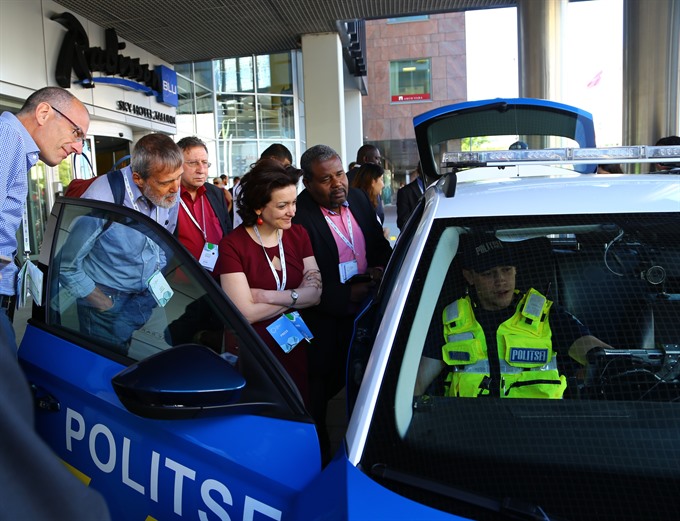 |
| Connected: A police officer demonstrates a mobile workstation installed in his patrol car. The mobile workstation provides officers in the field almost instantaneous access to vital information such as place of residence, images, telephone numbers or driving licence data. — VNS Photo Truong Son |
Viet Nam News
By Hong Minh
Karim Heredia, a software engineer from Guatemala, moved to his wife’s homeland Estonia some 10 years ago in search of better work opportunities than in crisis-hit Ireland.
However, after some time living and working in the Estonian capital Tallinn, Karim discovered a few other good things he had not seen outside the small Baltic state. He is living in the digital future.
“When you are a foreigner and get your Estonian ID, you are also getting your electronic identity. With that, you can file taxes online, access information about property, bank accounts, mobiles, whatever services you need,” he shared his experiences.
Karim explained that with a local ID number, a person automatically gets a local e-mail address at the eesti.ee domain that allows users to redirect messages to a personal account.
“With that, you never miss official communications, such as when it is time to file your taxes,” he said.
Like many Estonians, Karim does not have to leave his house to visit the tax offices. He can also deal with a number of procedures right on his laptop or mobile phone.
“You get a notification that your taxes are ready to file, you login to the tax office site, sign in, check that they have the correct information collected from your company, employer and so on, sign with your ID card, and that’s it,” he said, adding that it takes as little as five minutes for such procedures.
According to Karim, the e-ID also has legal validity and you can sign documents electronically anywhere in the world, giving the example that someone wanting to apply for a car lease wouldn’t necessarily have to show up at the bank.
“They send you some forms, you put your ID card in your computer reader, sign the document electronically, and send it back and that’s it,” he said.
“It’s the equivalent of putting your signature on paper in front of the bank official or lawyer.”
Karim and his family are among some 1.3 million people in Estonia who are enjoying the advanced technology and digital solutions ranked among the best in the world. Owning an Estonian ID card will provide access to up to 1,500 digitalised public services throughout the country. So far, 94 per cent of Estonian citizens have an electronic ID, which allows them to access and use the e-government information system. This is a hierarchy of connection services and databases, thanks to which it is easy to implement new services and applications and transition to the blockchain system is also straight forward.
 |
| Easy: People relax in Estonia’s capital Tallinn. Up to 99 per cent of services in Estonia are online so that people can pay taxes or vote in elections electronically. — VNS Photo Hong Minh |
“Up to 99 per cent of services in Estonia are online while the internet is a social right of the people,” said Indrek Onnik, project manager of e-Estonia Showroom, saying the country was taking great efforts to make life easier for citizens, so that they can even vote online.
“Only procedures related to marriage, divorce and selling your house are not digital. Yet!” Onnik said.
Statistics from the showroom reveal that thanks to e-government, Estonia has saved 2 per cent of the country’s GDP, more than 4,000 services are provided on a digital basis and more than 1 million health cards have been entered into the blockchain database.
Estonia has topped the world in taxation and digital economy. The government of Estonia has built an ecosystem of public services based on blockchain technologies such as e-identification, e-Court, e-Police, e-health, e-Vote, e-Register, e-tax and e-school. In Estonia, 98 per cent of companies are established online, 99 per cent of banking transactions are conducted online and up to 95 per cent of tax declarations are filed online.
Health is one service that Estonia has successfully moved on to blockchain. For the purpose of absolute confidentiality of health information, but at the same time ensuring access to both competent individuals, the electronic ID card system used by e-Healthcare (Electronic Health Systems) applies the blockchain platform to ensure integrity.
Accordingly, the medical records of each individual are kept, tracked and updated, all data checks, corrections and details will be fully displayed. The result is that over 95 per cent of health data and 99 per cent of prescriptions have been digitalised, while 500,000 queries by doctors every year and 100 per cent of billing forms are electronic.
 |
| Smooth operation: Citizens wait for trams in Tallinn. Everyone who gets an Estonian ID can access free public transport. By getting an Estonian ID, you are also getting an electronic identity. — VNS Photo Truong Son |
The establishment of e-Government in Estonia is budgeted at 1.4 per cent of government expenditure each year.Estonia has also created a paperless Cabinet. The country has established an e-Cabinet Information System for monitoring and management of meeting schedules, research, processing of documents and electronic documents via the internet serving the Government and the Policy Consultation System (e-Consultation). The draft documents and policies, after being consulted by concerned parties through e-Consultation, will be sent to the e-Cabinet for study, acceptance and modification by the ministers. These systems reduce the time and paperwork for government, support inter-ministerial policy consultation, consult citizen comments on draft legal documents or draft policies.
Thanks to such efforts, Estonia leads among the Baltic states on the United Nations’ Electronic Government Development Index 2018, coming in 16th worldwide. The nation ranks first on the internet freedom index by Freedom House, the Global IT report on mobile network coverage, the tax competitiveness index by OECD, and the digital development index by Barclays. It also tops the entrepreneurship index by the World Economic Forum and EU digital economy and social index by the European Commission.
Estonian President Kersti Kaljulaid in a meeting recently with journalists from developing countries, including Viet Nam News, shared experiences from Estonia’s success in building e-government
“First of all, the most important point to start is to do it universally with all services on the same platform without limiting it to the public services,” she said, stressing the importance of allowing private companies to join the same platform.
“Secondly, we have to make sure that everybody has genuine access to these systems.”
“Finally, run training programmes for people. Make it very clear to the people. You cannot do it without a massive training exercise,” she said.
According to the Estonian President, building e-government is necessary to meet people’s needs.
“People and businesses are already on the internet so governments have no option – they have to follow,” she said. — VNS
OVietnam